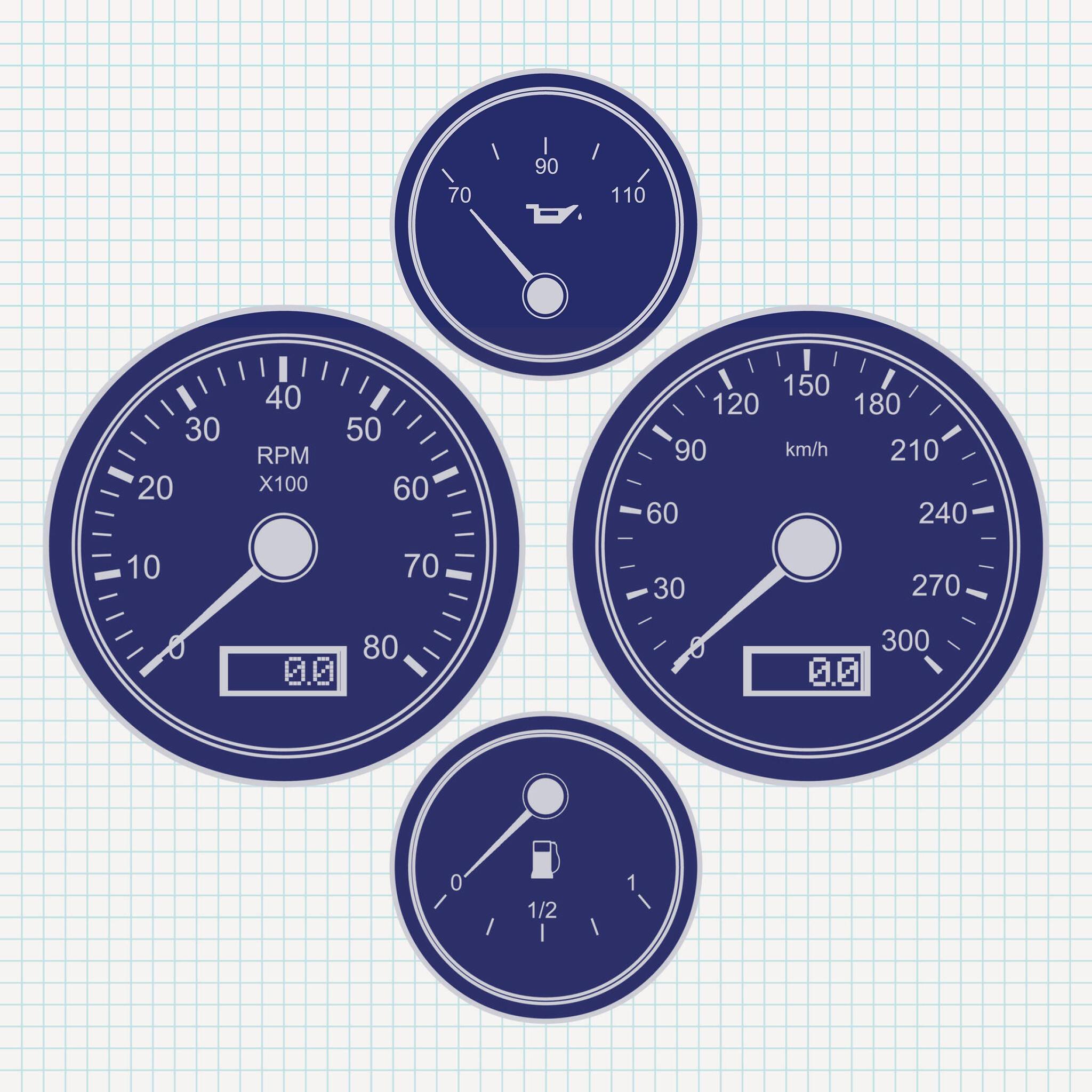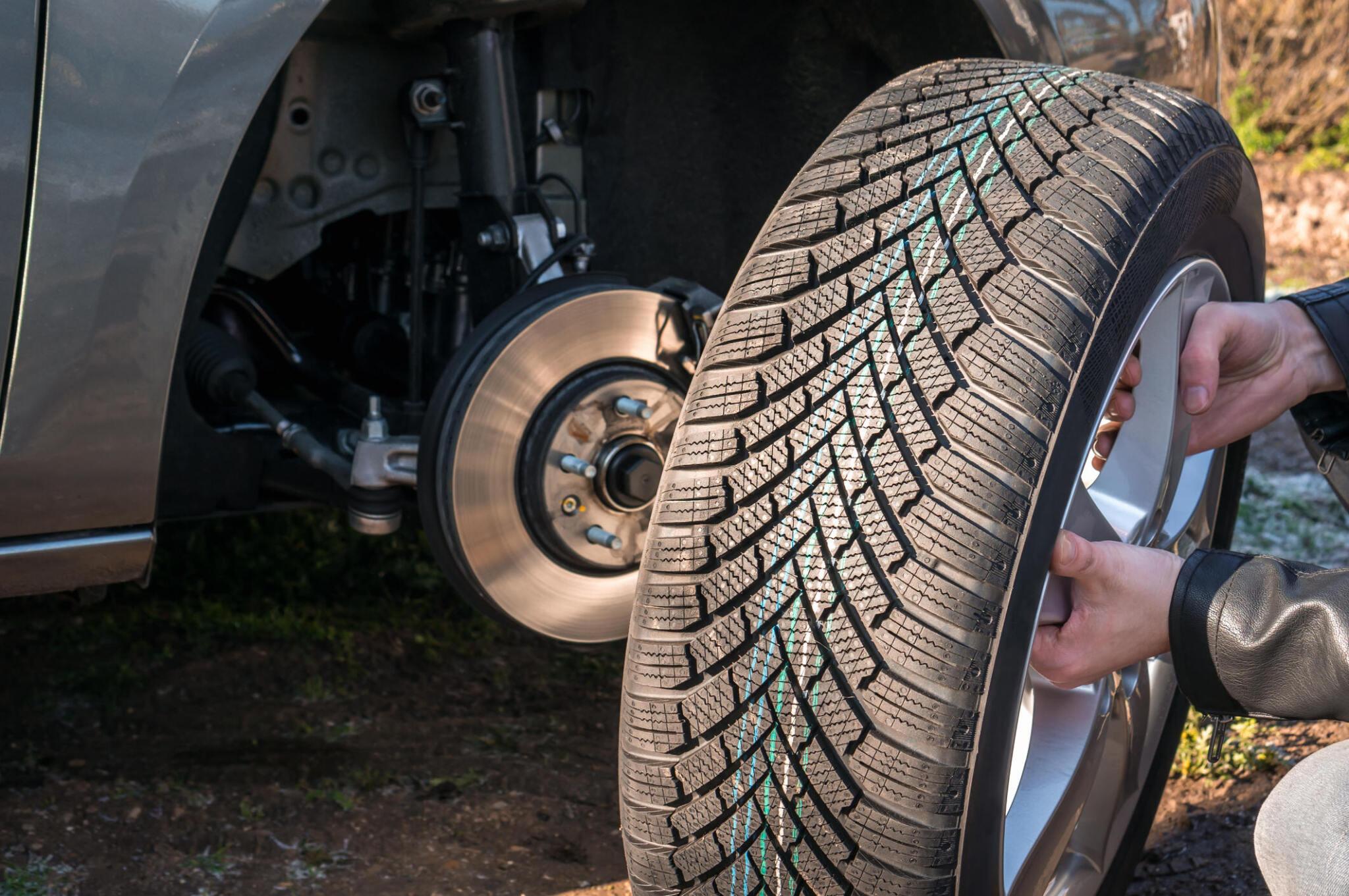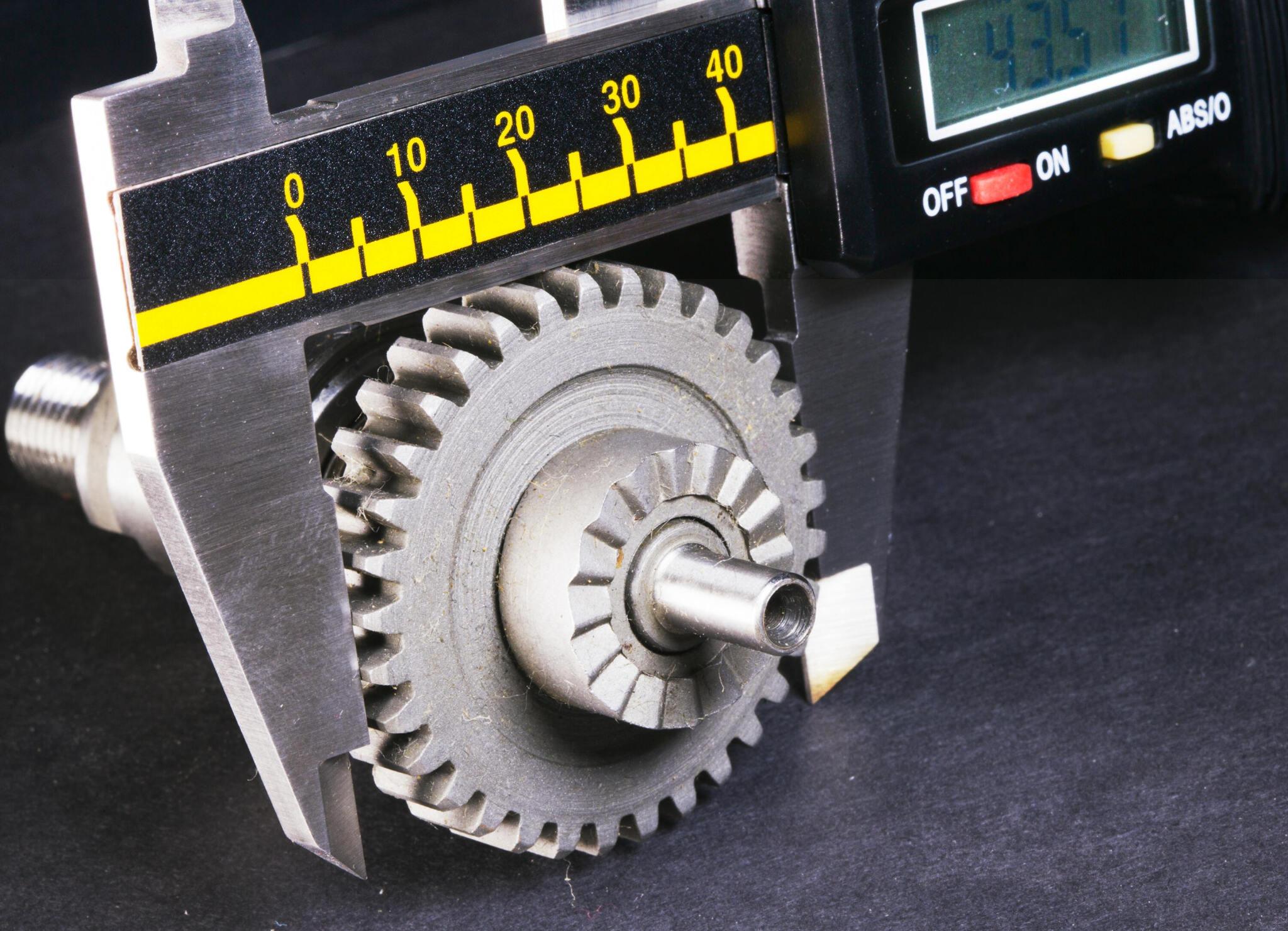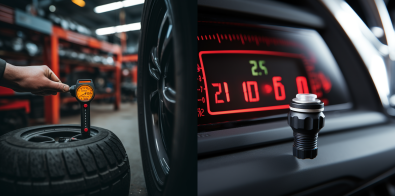Last Updated on April 21, 2024
TPMS Sensor Explained: Essential Safety or Optional Extra?
The advent of Tire Pressure Monitoring Systems (TPMS) marks a significant advancement in automotive safety and efficiency. Understanding the role and functionality of TPMS and recognizing the critical importance of tire pressure in vehicle safety is essential for modern drivers and vehicle owners. This article delves into these aspects, providing a comprehensive overview.
What is TPMS?
TPMS stands for Tire Pressure Monitoring System, a technology designed to monitor the air pressure inside the pneumatic tires of various types of vehicles. This system provides real-time tire pressure information to the driver via a gauge, pictogram display, or a simple low-pressure warning light.
Types of TPMS
There are two main types of TPMS: direct and indirect.
- Direct TPMS measures tire pressure directly from within the tire. Each tire has a sensor that communicates with the vehicle’s computer system, providing accurate, real-time information about the pressure in each tire.
- Indirect TPMS works with the vehicle’s Antilock Braking System (ABS) wheel speed sensors. If a tire is at a lower pressure, its diameter changes slightly and rotates at a different speed. The system detects this anomaly and alerts the driver.

How TPMS Sensors Function
Direct TPMS sensors are typically battery-powered and in the tire’s air chamber. They measure the pressure and sometimes the temperature inside the tire. This data is then transmitted wirelessly to the vehicle’s onboard computer system. Indirect TPMS, conversely, uses wheel speed data to infer tire pressure and requires no specific pressure sensor.
Importance of Tire Pressure in Vehicle Safety
Tire pressure plays a crucial role in ensuring vehicle safety and performance. This article delves into the significance of maintaining optimal tire pressure, highlighting how it impacts driving stability, fuel efficiency, and overall road safety.
Enhanced Safety
Proper tire pressure is crucial for safe driving. Underinflated tires can lead to various safety issues, including decreased steering precision, longer stopping distances, and an increased risk of tire blowouts. TPMS helps mitigate these risks by ensuring drivers know their tire pressure in real-time, allowing prompt corrective action.
Improved Vehicle Performance
Tire pressure impacts the vehicle’s handling, braking, and cornering. Optimal tire pressure ensures the car performs as designed, especially in critical situations.
Preventing Tire Wear
Underinflated or overinflated tires wear unevenly and have a shorter life. By maintaining correct tire pressure, TPMS prolongs tire lifespan, thus saving the owner money on replacement costs.
Fuel Efficiency
Tire pressure directly influences fuel efficiency. Underinflated tires increase rolling resistance, requiring more energy (fuel) to move and maintain speed. Maintaining proper tire pressure with the help of TPMS can significantly improve fuel efficiency.
Introducing TPMS in modern vehicles enhances safety, performance, and efficiency. Its role in maintaining proper tire pressure is a convenience and a critical aspect of vehicle maintenance and safety. As we become more reliant on technology for safe driving, understanding and utilizing systems like TPMS become increasingly important.
What is TPMS?
Tire Pressure Monitoring Systems (TPMS) are a vital component of modern vehicles, ensuring safety, performance, and efficiency by monitoring and maintaining optimal tire pressure. In this section, we will explore the evolution of TPMS technology, the two main types of TPMS (Direct and Indirect), and how TPMS works to keep your vehicle’s tires in optimal condition.
The Evolution of Tire Pressure Monitoring Systems
The development of TPMS technology has been driven by the increasing emphasis on safety and environmental concerns in the automotive industry. Here’s a brief overview of its evolution:
- Early Warning Systems: The concept of monitoring tire pressure dates back to the early 20th century when basic pressure monitoring systems were introduced. These systems were rudimentary and relied on simple pressure gauges.
- First-generation TPMS: The first-generation TPMS began to appear in luxury vehicles in the late 1980s and early 1990s. These systems typically used indirect methods, such as measuring wheel speed, to infer tire pressure. While they were a step forward, their accuracy was limited.
- Direct TPMS: Direct TPMS, introduced in the early 2000s, marked a significant advancement. It involved placing pressure sensors inside each tire to provide accurate, real-time data. This technology has become the standard in many modern vehicles.
- Legislation and Regulation: Various countries and regions have mandated the use of TPMS to improve road safety and reduce fuel consumption. For example, the United States required TPMS in all new vehicles starting in 2007.
Types of TPMS: Direct vs. Indirect
There are two primary types of TPMS, each with its advantages and disadvantages:
- Direct TPMS: Direct TPMS measures tire pressure directly from within each tire using specialized sensors. These sensors provide accurate, real-time data, making them highly reliable. They can also monitor tire temperature. However, direct TPMS systems are generally more expensive to install and maintain due to the need for sensors in each tire.
- Indirect TPMS: Indirect TPMS, on the other hand, does not use specific pressure sensors. Instead, it relies on existing sensors in the vehicle, such as the Antilock Braking System (ABS) wheel speed sensors, to monitor tire pressure indirectly. While indirect TPMS is more cost-effective, it may not provide as accurate and immediate data as direct TPMS.
How TPMS Works
Direct TPMS systems operate based on the following principles:
- Pressure Sensor: Each tire has a pressure sensor that measures the air pressure inside the tire.
- Data Transmission: The pressure sensors transmit data wirelessly to the vehicle’s onboard computer system.
- Display to the Driver: The vehicle’s computer processes the data and displays it to the driver through a gauge, pictogram display, or warning light on the dashboard.
- Alerts: If the system detects that tire pressure is too low (below a predefined threshold), it triggers a warning to alert the driver.
- Real-time Monitoring: TPMS continuously monitors tire pressure while the vehicle operates, providing immediate feedback to the driver.
Indirect TPMS monitors tire pressure based on changes in wheel speed, assuming that a significant change in speed indicates a tire issue.
TPMS technology has advanced greatly, becoming a crucial safety and performance feature in modern vehicles. Whether through direct or indirect monitoring, TPMS ensures that drivers are aware of their tire pressure, helping prevent accidents, prolong tire life, improve fuel efficiency, and reduce vehicle environmental impact. Understanding how TPMS works and the different types available can help vehicle owners make informed decisions about their maintenance and safety.
The Benefits of TPMS
Tire Pressure Monitoring Systems (TPMS) offer a wide range of benefits that go beyond simply alerting drivers to low tire pressure. This section will explore how TPMS enhances road safety, improves fuel efficiency, extends tire life, and contributes to environmental sustainability.
Enhancing Road Safety
Safety is paramount on the road, and TPMS plays a crucial role in enhancing it:
- Early Warning: TPMS provides drivers with an early warning when tire pressure drops below a safe level. This early alert helps prevent accidents caused by underinflated tires, which can lead to loss of control, skidding, and blowouts.
- Better Handling: Properly inflated tires improve vehicle handling, especially during emergency maneuvers. This can be critical in avoiding collisions and maintaining control in adverse road conditions.
- Reduced Stopping Distance: Maintaining correct tire pressure reduces the distance required to stop a vehicle. In emergency braking situations, shorter stopping distances can mean the difference between a near miss and a collision.
- Preventing Tire Blowouts: Underinflated tires are more prone to blowouts, which can be catastrophic at high speeds. TPMS helps prevent blowouts by keeping drivers informed of tire pressure abnormalities.
Improving Fuel Efficiency
Fuel efficiency is a concern for both vehicle owners and environmental conservation. TPMS contributes to better fuel economy in the following ways:
- Reduced Rolling Resistance: Inflated tires increase rolling resistance, making the engine work harder to move the vehicle. Properly inflated tires, thanks to TPMS, reduce this resistance, leading to improved fuel efficiency.
- Optimal Engine Performance: Maintaining proper tire pressure ensures that the engine operates at its most efficient level. When tires are underinflated, the engine must work harder to compensate, increasing fuel consumption.
- Cost Savings: Improved fuel efficiency translates to cost savings for vehicle owners. Over time, these savings can be substantial, making TPMS a cost-effective investment.
Extending Tire Life
Tires are a significant expense for vehicle owners, and TPMS helps extend their lifespan:
- Even Tire Wear: Properly inflated tires wear evenly across the tread surface. This means each tire can last longer before needing replacement, saving vehicle owners money.
- Prolonged Tread Life: Tires with even wear patterns have more consistent tread depth, which enhances their performance and longevity. TPMS ensures that tires are properly inflated to achieve this.
- Reduction in Heat Buildup: Underinflated tires generate more heat, which can lead to tire damage and premature failure. Maintaining the correct tire pressure through TPMS reduces heat buildup and extends tire life.
Environmental Benefits
Environmental considerations are increasingly important in the automotive industry, and TPMS contributes to environmental sustainability:
- Reduced Carbon Emissions: Improved fuel efficiency, driven by TPMS, results in lower vehicle carbon dioxide (CO2) emissions. This helps combat climate change and air pollution.
- Tire Recycling: Proper tire inflation extends tire life, reducing the number of tires that must be manufactured and disposed of. This has a positive impact on resource conservation and waste reduction.
- Less Rubber Waste: Longer-lasting tires generate less rubber waste, reducing the environmental impact of tire production and disposal.
TPMS technology offers a multifaceted set of benefits that encompass safety, fuel efficiency, tire longevity, and environmental conservation. Vehicle owners who invest in TPMS enjoy peace of mind on the road and contribute to safer, more efficient, and environmentally friendly transportation. It’s a win-win for both drivers and the planet.

Evaluating the Cost
When considering the installation of a Tire Pressure Monitoring System (TPMS), it’s essential to evaluate the costs involved, both in the short term and the long term. This section will delve into the various aspects of cost evaluation, including initial installation costs, long-term financial savings, and the overall cost-benefit analysis.
Initial Installation Costs
The initial cost of installing a TPMS can vary depending on several factors:
- Type of TPMS: The cost can differ significantly between direct and indirect TPMS systems. Direct TPMS, which involves sensors in each tire, tends to be more expensive due to the cost of sensors and installation. Indirect TPMS systems, on the other hand, are generally more cost-effective as they rely on existing vehicle sensors.
- Vehicle Make and Model: Some vehicles come equipped with TPMS as a standard feature, while others may not. If your car doesn’t have TPMS, the cost of retrofitting will vary based on the make and model.
- Quality of TPMS: Different brands and levels of TPMS sensors are available in the market. Higher-quality sensors may come at a premium but can offer greater accuracy and reliability.
- Professional Installation: While some vehicle owners may install TPMS themselves, professional installation is recommended for optimal accuracy and reliability. The cost of professional installation should be factored into the initial cost.
Long-term Financial Savings
While there are initial costs associated with TPMS installation, it’s essential to consider the potential long-term financial savings:
- Fuel Efficiency: Properly inflated tires improve fuel efficiency, resulting in significant savings over time. Less frequent refueling and reduced fuel consumption can offset the initial installation costs.
- Tire Lifespan: TPMS helps ensure that tires wear evenly and last longer. Extended tire life means fewer replacements, reducing the overall cost of tire maintenance.
- Prevention of Accidents: TPMS is critical in preventing accidents caused by underinflated tires. Avoiding accidents can save on repair costs, medical expenses, and potential increases in insurance premiums.
Comparing Costs vs. Benefits
When evaluating the cost of TPMS, it’s essential to weigh these costs against the benefits:
- Safety Benefits: TPMS enhances road safety by providing early warnings of tire pressure issues, potentially preventing accidents and injuries. The value of safety cannot be overstated.
- Fuel Savings: The improved fuel efficiency resulting from TPMS can lead to ongoing savings on fuel expenses. Over the life of a vehicle, these savings can be substantial.
- Tire Maintenance Costs: Extended tire life and reduced wear can lower maintenance and replacement costs.
- Environmental Impact: TPMS contributes to reduced carbon emissions due to improved fuel efficiency. This ecological benefit can align with eco-conscious drivers’ values.
While initial costs are associated with TPMS installation, the long-term financial savings, safety benefits, and environmental advantages often outweigh these costs. Vehicle owners need to consider the whole picture when evaluating the cost-effectiveness of TPMS and recognize that it’s an investment in safety, efficiency, and overall vehicle maintenance.
TPMS Maintenance and Troubleshooting
Tire Pressure Monitoring Systems (TPMS) ensure vehicle safety and performance. However, like any other component, they require maintenance and may encounter issues over time. In this section, we’ll explore routine maintenance tips to keep your TPMS in optimal condition, common TPMS issues, their solutions, and when to consider replacing your TPMS.
Routine Maintenance Tips
Maintaining your TPMS is essential to ensure its accuracy and reliability. Here are some routine maintenance tips:
- Tire Pressure Check: Regularly check your tire pressure using a reliable gauge. Ensure all tires are correctly inflated to the manufacturer’s recommended levels, as indicated in your vehicle’s manual or the driver’s door jamb.
- Battery Replacement: If your TPMS sensors use batteries, keep track of their lifespan. Depending on the sensor’s design, TPMS sensor batteries typically last 5 to 10 years. Replace the batteries as needed to ensure accurate readings.
- Sensor Inspection: Periodically inspect the physical condition of the TPMS sensors. Ensure they are securely attached to the valve stems and not damaged. Damaged sensors should be replaced promptly.
- Reset After Tire Rotation: If you rotate your tires, reset the TPMS system afterward. The TPMS sensors are often paired with specific tire positions; a reset is necessary to update this information.
- Professional Maintenance: Consider having your TPMS system checked and maintained by a professional during routine vehicle maintenance appointments. They can verify the system’s accuracy and address any issues.
Common TPMS Issues and Solutions
TPMS systems can encounter various issues that may affect their performance. Here are some common problems and their solutions:
- Sensor Failure: TPMS sensors can fail over time due to battery depletion or physical damage. When a sensor fails, it typically triggers a warning light on the dashboard. In such cases, the failed sensor should be replaced.
- Inaccurate Readings: If your TPMS provides incorrect readings, it could be due to sensor malfunctions or interference from other electronic devices. Consult a professional to diagnose and rectify the issue.
- Warning Light Illumination: If the TPMS warning light on your dashboard remains illuminated despite proper tire pressure, it may indicate a system malfunction. Professional diagnosis and repair are necessary to resolve this issue.
- TPMS Reset: After replacing tires or sensors, the TPMS system must be reset to ensure it recognizes the new components and provides accurate readings.

When to Replace Your TPMS
While routine maintenance and troubleshooting can address many TPMS issues, there may come a point when it’s necessary to consider replacing the entire TPMS system:
- Aging Sensors: If your TPMS sensors are reaching the end of their expected lifespan (typically 5 to 10 years), replacing the entire system with new sensors may be more cost-effective than replacing individual sensors as they fail.
- Frequent Sensor Failures: If you experience frequent sensor failures or recurring TPMS issues that are becoming costly, consider a complete system replacement for reliability.
- Upgrading to New Technology: If you have an older TPMS system, consider upgrading to newer technology that offers enhanced features, such as more accurate readings or additional data points like tire temperature.
Legal and Regulatory Aspects of TPMS
Tire Pressure Monitoring Systems (TPMS) are beneficial for vehicle safety and efficiency and are subject to various legal and regulatory requirements in different countries. In this section, we will explore the legal and regulatory aspects of TPMS, including the TPMS requirements in other countries and the importance of understanding vehicle compliance.
TPMS Requirements in Different Countries
TPMS regulations and requirements vary from one country to another. These regulations are often implemented to enhance road safety, reduce accidents, and promote environmental conservation. Here are some examples of TPMS requirements in different countries:
- United States: The United States has stringent TPMS regulations. Since September 1, 2007, all new vehicles sold in the U.S. must be equipped with TPMS. This requirement is governed by the National Highway Traffic Safety Administration (NHTSA) and applies to passenger cars, light trucks, and multipurpose passenger vehicles.
- European Union: In the European Union, TPMS regulations were phased in gradually. Since November 1, 2012, all new passenger cars must be equipped with TPMS. However, light commercial vehicles and heavy-duty vehicles have different compliance deadlines.
- Canada: Similar to the U.S., Canada mandates TPMS in new vehicles. The regulations align closely with those of the United States, including the requirement for a TPMS warning light on the dashboard.
- China: China introduced TPMS regulations in stages, starting with new passenger vehicles in 2011. These regulations focus on ensuring TPMS accuracy and performance.
- Japan: Japan has also implemented TPMS regulations, requiring TPMS on new vehicles to enhance road safety and fuel efficiency.
Vehicle owners and manufacturers must know the specific TPMS requirements in their respective countries to ensure compliance and safety.
Understanding Vehicle Compliance
Understanding vehicle compliance with TPMS regulations is crucial for both manufacturers and vehicle owners:
- Manufacturers: Vehicle manufacturers must ensure that their vehicles meet the TPMS requirements of the countries where they intend to sell them. This involves installing TPMS systems that comply with the local regulations and standards.
- Vehicle Owners: Vehicle owners should be aware of their vehicle’s compliance with TPMS regulations, mainly if they import or export vehicles to different countries. Non-compliant vehicles may face legal issues or safety concerns.
- Aftermarket TPMS: Vehicle owners who want to retrofit TPMS systems or replace TPMS sensors must choose components that meet local TPMS requirements to ensure compliance and functionality.
Importance of Compliance
Compliance with TPMS regulations is essential for several reasons:
- Safety: TPMS regulations aim to enhance road safety by alerting drivers to tire pressure issues and reducing the risk of accidents caused by underinflated tires.
- Legal Requirements: Non-compliance with TPMS regulations can lead to legal issues, including fines or penalties.
- Environmental Impact: TPMS also contributes to environmental conservation by improving fuel efficiency and reducing carbon emissions, aligning with global efforts to reduce pollution.
TPMS regulations vary by country and aim to improve road safety, vehicle performance, and environmental sustainability. Understanding and complying with these regulations is essential for vehicle manufacturers, owners, and anyone involved in the automotive industry to ensure safety and legal compliance. It’s a critical aspect of the evolving automotive landscape as technology plays a pivotal role in vehicle safety and environmental impact.
TPMS Sensor Mounting Arrangements and Replacement Procedures
In modern automotive technology, Tire Pressure Monitoring Systems (TPMS) have become crucial for ensuring vehicle safety and performance. These systems help monitor tire pressure in real time, alerting drivers to potential issues such as underinflated tires. However, TPMS sensors come in various mounting arrangements with installation requirements and considerations.
This informative guide will explore the three main TPM sensor mounting arrangement types: Snap Fit / Through TPM Sensor, Clamp In / Bolt TPM Sensor, and Ford Banded TPMS Sensor. We’ll explore the characteristics of each arrangement and the tools and techniques needed for installation.
Furthermore, we will discuss the importance of replacing a Tire Pressure Sensor, covering the reasons for replacement and the essential steps to ensure a seamless sensor replacement process. As we navigate the TPMS sensor installation and replacement world, you’ll gain valuable insights into effectively maintaining your vehicle’s tire pressure monitoring system. Let’s begin understanding TPMS sensor mounting arrangements and replacement procedures.
Types of TPM Sensor Mounting Arrangements
The main types of TPM sensor mounting arrangements include the Snap Fit/Pull Through TPM Sensor, known for its easy installation and minimal training requirement; the Clamp In/Bolt In TPM Sensor, which is widely used and may require specific tools for mounting; and the Ford Banded TPMS Sensor, a unique arrangement formerly used by Ford, characterized by its placement on the rim center and attachment with a steel band.
1. Snap Fit / Pull Through TPM Sensor
- Schrader-based TPM electronics with a pull-through fitting.
- No special equipment is required for installation; it is just a standard rubber stem puller.
- EZ-sensor® is an example of a snap-fit TPMS Sensor.
Advantages:
- No need for expensive tooling.
- Fast and straightforward assembly.
- It easily replaces other TPMS types.
- Replaceable snap-in body type.
- Patented design widely used in automotive OEM.
- Minimal training is required for repair technicians.
- Suitable for both steel and aluminum wheels.
- Ready to use right out of the box.
2. Clamp In / Bolt In TPM Sensor
- Many manufacturers use the most popular type of fitting.
- Typically requires a dynamic programmable torque wrench or torque profiling gun for mounting.
- You may also need a mounting jig to ensure the correct angle and seal formation.
- Some manufacturers specify specific torque profiles and torquing processes for excellent residual torque.
3. Ford Banded TPMS Sensor
- It was used exclusively by Ford and is now superseded.
- It is still found in the original fitments of many Ford vehicles.
- The TPMS sits on the rim center, opposite the valve stem, and is held in place with a steel band.
Replacing a Tire Pressure Sensor
- Reasons for replacement include a faulty or damaged sensor and new wheels or tires (e.g., winter tires or custom wheels).
- Use a TPMS tool to audit the vehicle and diagnose sensor issues (e.g., faulty sensor battery, blocked pressure port).
- During tire removal, technicians should be cautious to avoid damaging the sensor.
- Ensure the correct replacement part, as sensors from different manufacturers can look similar and be easily confused.
Making the Decision: Is TPMS Right for You?
Deciding whether Tire Pressure Monitoring Systems (TPMS) are the right choice for your vehicle ensures safety, performance, and efficiency. This section will explore how to make an informed decision about TPMS, including assessing your driving needs, understanding TPMS’s suitability for different types of vehicles, and hearing personal stories from individuals who have experienced TPMS in action.
Assessing Your Driving Needs
Before opting for TPMS, assessing your driving needs and habits is essential. Here are some factors to consider:
- Driving Conditions: Think about the typical driving conditions you encounter. Do you primarily drive on highways, city streets, or off-road? Different driving conditions may have varying impacts on tire pressure.
- Mileage: Consider your daily and weekly mileage. Frequent driving may result in more significant fluctuations in tire pressure, making TPMS particularly beneficial.
- Weather: Tire pressure can be affected if you live in an area with extreme weather conditions, such as hot summers or cold winters. TPMS can help you monitor these changes.
- Vehicle Type: The type of vehicle you drive matters. TPMS is commonly found in passenger cars but may also be helpful for trucks, SUVs, and other vehicles. Assess whether your vehicle type warrants TPMS.
- Personal Preferences: Some individuals prefer the convenience of real-time tire pressure monitoring, while others may rely on periodic manual checks. Your personal preferences and comfort level with technology should be considered.
TPMS for Different Types of Vehicles
TPMS is suitable for various types of vehicles, each with its unique needs:
- Passenger Cars: TPMS is almost standard in passenger cars. It enhances safety, fuel efficiency, and overall vehicle performance.
- Trucks and SUVs: Larger vehicles like trucks and SUVs can benefit from TPMS, mainly if used for towing or carrying heavy loads. Proper tire pressure is critical for these applications.
- Off-Road Vehicles: Off-road enthusiasts may find TPMS valuable for maintaining tire pressure during off-road adventures, ensuring optimal traction and performance.
- Recreational Vehicles (RVs): RVs often have multiple tires, and TPMS can help monitor and maintain tire pressure for safe and comfortable travel.
Personal Stories: TPMS Experiences
One of the most valuable ways to understand the benefits of TPMS is by hearing from individuals who have experienced it firsthand. Here are some personal stories from TPMS users:
- Safety First: Jane, a daily commuter, shares how TPMS alerted her to a slow tire leak during a rainy morning. She addressed the issue before it led to a potential hydroplaning situation.
- Peace of Mind: Mike, an RV enthusiast, recounts how TPMS provided peace of mind during long cross-country trips. He could monitor tire pressure in real time, preventing potential blowouts on remote highways.
- Fuel Savings: a truck owner, Sarah, discusses how TPMS helped her save on fuel costs by maintaining proper tire pressure. Improved fuel efficiency translated to significant savings over time.
- Quick Response: John, an off-road enthusiast, recalls how TPMS allowed him to adjust tire pressure on the fly when navigating challenging terrains, ensuring better traction and control.
Deciding whether TPMS suits you involves assessing your driving needs, understanding its suitability for your vehicle type, and considering the personal stories of TPMS users. TPMS can provide safety, convenience, and savings, making it a valuable addition to many vehicles. Ultimately, the decision should align with your driving habits, preferences, and the specific demands of your car.
Future of TPMS Technology
The future of Tire Pressure Monitoring Systems (TPMS) holds exciting prospects as technology continues to advance. In this section, we will explore the innovations in TPMS technology and its evolving role in autonomous vehicles.
Innovations in TPMS
TPMS technology continuously evolves to provide more accurate and comprehensive tire pressure monitoring. Here are some key innovations in TPMS:
- Advanced Sensors: New sensor technologies, such as capacitive sensors, offer higher accuracy in measuring tire pressure. These sensors can detect even minor pressure changes, ensuring precise monitoring.
- Integration with Vehicle Systems: TPMS is becoming more integrated with other vehicle systems, such as the onboard computer. This integration allows for real-time adjustments to tire pressure and enhanced vehicle stability.
- Wireless Connectivity: Wireless TPMS systems are on the horizon, enabling tire pressure data to be transmitted to the vehicle’s computer or a mobile app. This remote monitoring feature enhances drivers’ convenience.
- Predictive Analytics: Some TPMS systems are incorporating predictive analytics to anticipate tire pressure issues before they occur. This proactive approach can help prevent tire-related accidents.
- Self-Adjusting Systems: TPMS systems that can automatically adjust tire pressure based on driving conditions are being developed. These systems optimize tire pressure for fuel efficiency, road conditions, and load weight.
The Role of TPMS in Autonomous Vehicles
As autonomous vehicles become a reality, TPMS technology will play a vital role in their operation and safety:
- Data for Autonomous Control: Autonomous vehicles use extensive data to make decisions. TPMS provides valuable real-time data on tire conditions, which can be used to enhance vehicle control and safety.
- Safety Redundancy: Safety is paramount in autonomous vehicles. TPMS serves as a redundant system to verify tire pressure and detect issues that could affect vehicle stability and performance.
- Predictive Maintenance: Autonomous vehicles can benefit from predictive maintenance enabled by TPMS. The system can identify tire wear patterns and recommend tire replacements before they become critical.
- Enhanced Fuel Efficiency: Autonomous vehicles are designed for optimal efficiency. TPMS contributes to this by maintaining proper tire pressure, which directly impacts fuel efficiency.
- Smoother Ride: Autonomous vehicles aim to provide passengers with a comfortable experience. TPMS ensures optimal tire pressure, resulting in a softer and more comfortable ride.
The future of TPMS technology is marked by innovation, integration with vehicle systems, and a pivotal role in the development of autonomous vehicles. These advancements are set to enhance safety, convenience, and efficiency on the road, making TPMS a critical component of the evolving automotive landscape. As technology continues to progress, TPMS will play a significant role in shaping the future of transportation.

Conclusion & Recommendations
As we conclude our comprehensive guide on Tire Pressure Monitoring Systems (TPMS), we’ve explored every aspect of this essential technology, from understanding its functionality to evaluating its benefits and legal requirements. In this final section, we’ll summarize key points and offer our final recommendations regarding TPMS. Plus, we’ll help you take the next step in ensuring your vehicle’s safety and performance by providing a convenient way to buy tires from our website, Tire Easy.
Summary of Key Points
Let’s recap the key points covered in this guide:
- Understanding TPMS: TPMS is a technology that monitors tire pressure in real-time and alerts drivers to underinflated tires, enhancing safety and performance.
- Importance of Proper Tire Pressure: Proper tire pressure is crucial for safety, fuel efficiency, tire lifespan, and environmental impact.
- Types of TPMS: There are two main types of TPMS: direct and indirect, each with advantages and limitations.
- Benefits of TPMS: TPMS enhances road safety, improves fuel efficiency, extends tire life, and has environmental benefits.
- Evaluating the Cost: While there are initial installation costs, TPMS often provides long-term financial savings, making it a valuable investment.
- Maintenance and Troubleshooting: Routine maintenance and troubleshooting are essential to ensure TPMS accuracy and reliability.
- Legal and Regulatory Aspects: TPMS is subject to various legal and regulatory requirements in different countries to enhance road safety and environmental conservation.
- Making the Decision: Deciding whether TPMS suits you involves assessing your driving needs, understanding suitability for different vehicles, and considering personal stories from TPMS users.
- Future of TPMS Technology: TPMS is evolving with innovations in sensors, integration with vehicle systems, and a growing role in autonomous vehicles.
Final Recommendations
Based on the information provided in this guide, we offer the following final recommendations:
- Prioritize Safety: Safety should always be a top priority. If your vehicle still needs to be used to enhance road safety, consider installing TPMS.
- Regular Maintenance: Whether you have TPMS or not, make it a habit to check and maintain proper tire pressure regularly. This simple step can prevent accidents and save on fuel costs.
- Compliance with Regulations: Ensure that your vehicle complies with TPMS regulations in your country. Compliance keeps you legal and contributes to road safety and environmental sustainability.
- Explore TPMS Technology: Embrace the advancements in TPMS technology, such as wireless monitoring and predictive analytics. These innovations can offer convenience and enhanced safety.
- Consider Future Needs: If you plan to invest in an autonomous vehicle in the future, understand that TPMS will play a vital role in its operation and safety.
- Buy Tires from Tire Easy: Having the right tires is essential to ensuring your vehicle’s safety and performance. Visit Tire Easy to explore a wide range of high-quality tires that suit your vehicle’s needs.
Buy Tires from Tire Easy
Now that you have gained valuable insights into the importance of proper tire pressure and the role of TPMS in enhancing safety and performance, it’s time to take action. Ensure your vehicle is equipped with the right tires by visiting our website, Tire Easy.
Explore our extensive selection of tires, find the perfect fit for your vehicle, and purchase to experience the benefits of optimal tire performance. Your safety on the road starts with the right tires, and Tire Easy is here to help you make the right choice.
Thank you for choosing Tire Easy as your trusted source for quality tires and valuable information on TPMS technology. We look forward to serving your tire needs and ensuring your vehicle’s safety and performance. Safe travels!
FAQs
Are TPMS Sensors Necessary?
TPMS sensors are necessary for maintaining tire pressure and ensuring road safety. They provide real-time alerts about underinflated tires, reducing the risk of accidents and improving fuel efficiency.
What Are the Disadvantages of TPMS?
While TPMS offers many benefits, it can be an added cost during initial installation and may require occasional maintenance. False alerts due to sensor malfunctions can also be a drawback.
Are TPMS Sensors Worth Replacing?
Yes, TPMS sensors are worth replacing when they reach the end of their lifespan (typically 5 to 10 years) or if they fail. Properly functioning TPMS sensors contribute to safety and fuel efficiency.
How Many Years Do TPMS Sensors Last?
TPMS sensor lifespan typically ranges from 5 to 10 years, depending on the sensor type and usage. Regular battery replacement can extend their lifespan.
Can You Install Your TPMS?
While it is possible to install TPMS sensors yourself, having a professional handle the installation is recommended to ensure accuracy and reliability.
Do TPMS Sensors Have to Be Programmed Before Installing?
TPMS sensors must be programmed to your vehicle’s specific requirements before installation. This ensures they provide accurate tire pressure readings.
How Do You Set Up a TPMS Sensor?
Setting up a TPMS sensor involves programming it with your vehicle’s correct tire pressure specifications. This is typically done using a specialized tool or by a professional technician.
Who Can Install TPMS Sensors?
Certified automotive technicians or professionals best perform TPMS sensor installation with the equipment and expertise to ensure proper setup and functionality.









